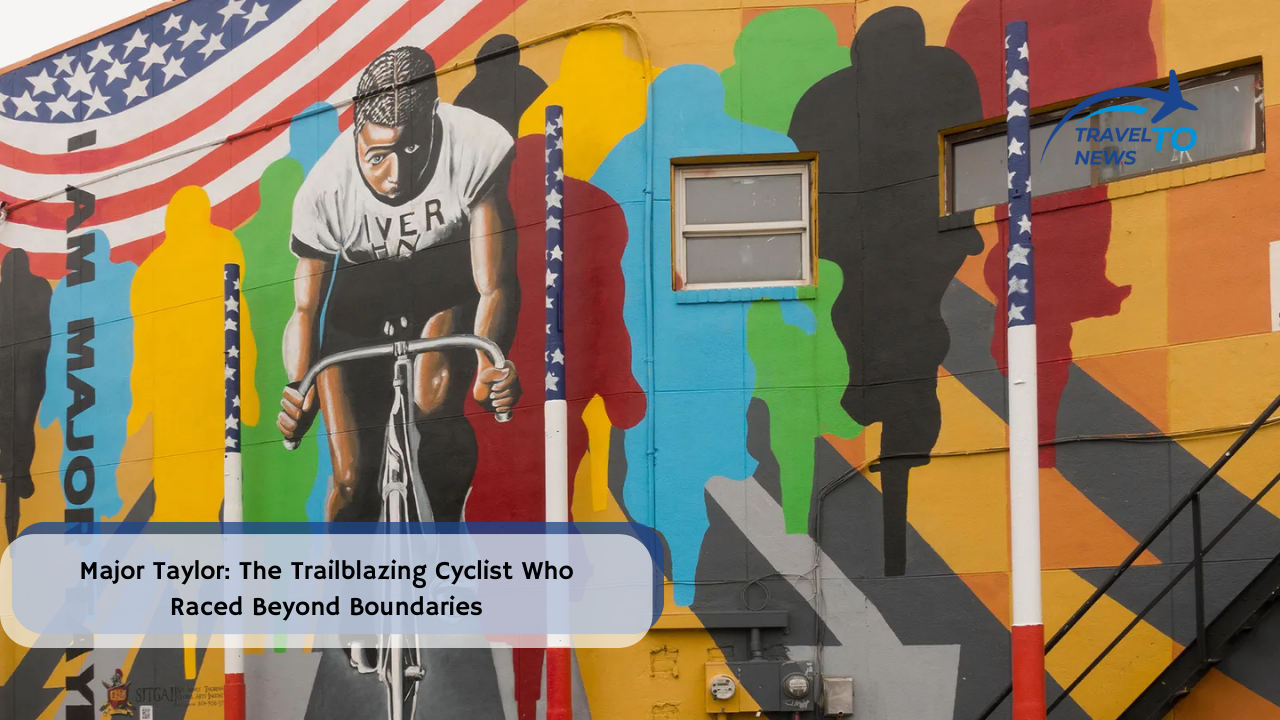Major Taylor: The First Black American Global Sports Superstar

the pioneering journey of Major Taylor, the first Black American athlete to achieve global fame in sports, his struggles, and accomplishments.
In the annals of sports history, there are figures whose legacies transcend mere athletic achievements, becoming emblematic of the struggles and victories of the times they lived in. One such legend, often unsung beyond the cycling circles, is Marshall “Major” Taylor. An icon of speed, endurance, and unyielding determination, Major Taylor wasn’t just a champion cyclist—he was a trailblazer who pedaled through the pervasive racial prejudice of his time to emerge as the first Black American global sports superstar.
Table of Contents
The Wheels of Change
At the turn of the 20th century, when cycling was one of the world’s most popular sports, Major Taylor broke not only world records but also racial barriers. Born in 1878 against the backdrop of post-Civil War America, Taylor faced the daunting realities of segregation and systemic racism. Yet, his journey from a young bicycle shop errand boy in Indianapolis to becoming a world champion is a tale of grit, grace, and groundbreaking achievement.
Taylor’s extraordinary physical prowess is undeniable—he clinched his first significant victory at just 18 years old, capturing the world’s gaze. But the undeniable weight of his legacy lies in his monumental role as a pioneer who challenged and changed the societal norms of his time. In an era where many sought to dissuade and derail him, Taylor charged forth with an unwavering commitment to his sport and himself.
His resilience in the face of adversity transformed Major Taylor into an embodiment of hope and a symbol for racial equality, heralding the indomitable human spirit. Racing across the United States, Europe, and Australia, he dazzled spectators with his incredible sprints and tireless energy, earning him international acclaim and a place in the pantheon of sporting greats.
Though his triumphs should have granted him abundance and acclaim, Taylor’s years on the velodrome were marred by discrimination and financial strife. Yet, his influence has endured, etching his name into the foundation of not just cycling, but the broader pursuit of global racial unity and equity in sports.
As we delve into the undulating saga of Major Taylor’s life, let us remember that beyond the velodrome victories and the medals, his true legacy lies in the undaunted spirit of a man who rode not just to win races but to affirm the dignity and potential of Black athletes across the world. His story isn’t simply about the cycling legend who became the first Black American global sports superstar—it’s about a man who pedaled into history, inspiring countless others to ride in his wake.
The Unlikely Champion: Major Taylor’s Early Life and Upbringing
Every legend has a beginning, and Marshall “Major” Taylor’s echoes with humble beginnings, unyielding resilience, and an unwavering will. Born into a world that was far from welcoming, his journey from a child in rural Indiana to a world-renowned cycling phenomenon is steeped in adversity, ambition, and astounding accomplishments.
From Humble Beginnings to Historic Heights
Marshall Walter “Major” Taylor was born on November 26, 1878, in Indianapolis, Indiana, barely 13 years post the abolition of slavery in America. The second of eight children born to Gilbert and Saphronia Taylor, his family lived in relative poverty as his parents worked tirelessly to provide for their large family.
Experiencing the throbbing pangs of racial prejudice early in life, his family moved to a predominantly white neighborhood where they were one among three Black families. It was here that Taylor was given his first bicycle, a significant event that spun the wheels of his momentous journey.
At a tender age, after his father enlisted in the army and with his family unable to support him, Taylor had to move out and began to work for a wealthy white family. The Southards. The family embraced young Taylor, treated him akin to their own son, and exposed him to a lifestyle far removed from his underprivileged beginnings. It was in their care that he received his first bicycle, igniting a passion that would direct the course of his life.
The Spark Ignites
By the time he turned twelve, Taylor was working at a local bicycle shop. Recognized for his lean physique and natural athleticism, the owner of the shop, Tom Hay, paid young Taylor to perform cycling stunts outside the shop, often dressed in a military uniform. The captivating performances earned him the nickname “Major,” a moniker that stuck and eventually overshadowed his real name.
It soon became apparent that Taylor’s affinity for cycling extended beyond mere tricks. He swiftly graduated from stunt performances to competitive racing, participating in his first race at just 13 years old. Despite numerous glaring racial and socio-economic barriers, Taylor’s burgeoning talent was undeniable.
Major Taylor’s early life was, by no means, an easy ride. Yet, it was within these trying times that Taylor discovered his true calling and began pedaling his way towards becoming the world’s fastest cyclist and far more – a beacon of hope in the fight against racial discrimination. The robust foundation for his future greatness was being laid down, one cycling race at a time, in the heartland of Indianapolis. He was spinning towards a destiny filled with victories, hardships, and an extraordinary legacy that continues to inspire athletes today, making him a true testament to perseverance and courage.
Major Taylor’s Legacy: A Timeline of Triumph

In the late 19th and early 20th centuries, a period marked by the struggle for racial equality, emerged a cyclist who would surpass the dominant narratives of his time to become a symbol of sporting excellence. Marshall “Major” Taylor’s career spanned remarkable victories and shattering world records, each a pedal stroke towards immortality. Here, we chronicle the pivotal moments that defined his journey and solidified his name in the annals of sport.
The Early Milestones
Major Taylor professional career took off when he was just a teenager. In 1896, at the age of 18, he moved to Worcester, Massachusetts, a city more tolerant of diversity than his hometown. This leap allowed him to train and compete more earnestly, and it was here that Taylor’s career gained momentum. His first major achievement arrived swiftly, as he broke two world records at the Capital City Track in Indianapolis.
A Champion Crowned
In 1898, a year that saw the Spanish-American War and the annexation of Hawaii, Major Taylor triumphed at the one-mile sprint at the National Championship in Montreal, Canada, realizing his status as a world-class athlete. This victory was remarkable, considering the racial climate of the era, as Taylor was not allowed to race in the South and faced continuous discrimination in the North.
The World’s Fastest Cyclist
Bearing poise and reliability unparalleled, Taylor laid claim to the prestigious title of 1899 World Sprint Champion in Montreal. He became the second Black athlete to win a world championship in any sport, not just cycling. His victory was a resounding proclamation of his prowess, making him the fastest cyclist in the world—a title he carried with grace and humility.
Breaking Boundaries and Records
The following year, Major Taylor embarked on a groundbreaking European tour, championing events in Germany, France, and Australia, deepening his global footprint. 1901 saw him shatter the world record for flying start paced races over the distance of a quarter-mile in Paris. Taylor continued to amass victories, claiming the American Sprint Championship once more in 1900 and 1901, assertions of his extraordinary athleticism and competitive spirit.
The Indomitable Spirit
Throughout his career, Taylor faced racism that sought to stifle his prowess; he was often sabotaged during races, barred from competing, and suffered vile abuse. Despite these challenges, Taylor stood resilient, adhering to a personal code of conduct that radiated dignity and grace. His sportsmanship and powerful advocacy against racial injustice elevated his status beyond sports, making him an icon for equality and determination.
A Victory Lap and a Fond Farewell
By 1910, after an illustrious career, Major Taylor retired from cycling at the age of 32. He had raced and won across the United States, Europe, and Australia, becoming an international superstar, a role model for Black athletes, and a proof that excellence knows no racial bounds.
Sadly, despite Taylor’s success, the financial gains eluded him, and his later years were marked by economic difficulties. However, his post-retirement autobiography, “The Fastest Bicycle Rider in the World,” chronicled his life, battles, and triumphs, serving as a beacon for aspiring athletes.
The Unending Legacy
Major Taylor’s impact on sport and society was monumental. His career stood not only as a testament to his superlative athleticism but also to his enduring strength of character in the face of prejudice. Through sweat, steel, and sheer persistence, Major Taylor redefined what it meant to be an athlete and what it meant to be a man of color in a deeply segregated world.
Honoring his legacy, the Major Taylor Association continues to spread his incredible story, encouraging young cyclists and advocating for diversity in cycling and athletics. Though Taylor has long since crossed his final finish line, his achievements continue to inspire and remind us that greatness is earned through fortitude, fairness, and the kind of speed that can conquer more than just the track.
The Enduring Impact of Major Taylor: Revolutionizing Sports and Society

In reflecting upon the legacy of Marshall “Major” Taylor, one cannot merely sum it up as a tale of athletic prowess. His remarkable career stretches beyond his time, embodying a journey of relentless pursuit of excellence in a world that sought to diminish his worth because of the color of his skin.
Racial Barriers Shattered
In the landscape of American sports, Major Taylor’s story stands out as a beacon of hope and resistance. His story is a template of trials and triumphs, shattering the racial barriers of his time. As the first prominent Black cyclist in a predominantly white sport, his success challenged the racial stereotypes of the late 19th and early 20th centuries. His indomitable spirit and unwavering determination in light of overt discrimination blazed a trail for future Black athletes.
Doors Opened for Future Athletes
Major Taylor’s victories on both national and global cycling circuits resonated far beyond the immediate celebration of a race won. In setting world records, winning national and international titles, he effectively pushed open the doors for future Black athletes. His career was a testament that race did not define one’s athletic abilities or one’s right to compete on the world stage. Major Taylor’s determination to compete in a sport from which he was often excluded demonstrated to future generations of minority athletes that they too had a place in the sporting world.
Major Taylor Association & Remembering A Hero
Today, the Major Taylor Association continues to honor his legacy, commemorating his athletic achievements and his contribution to racial equality. The association works towards inspiring youth through cycling, keeping Taylor’s legacy alive in future generations. The Historic Worcester Foundation has also recognized Major Taylor’s residence as a historical landmark, further preserving his memory.
In the wider sports industry, Major Taylor’s impact is widely recognized. From ESPN documentaries to numerous books, his tale of perseverance and strength in the face of adversity has been recounted and revered by many. In 2008, a statue dedicated to Taylor was unveiled at the Worcester Public Library, Massachusetts, where he lived and trained for much of his career. Furthermore, his name graces the state-of-the-art Major Taylor Velodrome in Indianapolis, standing as a reminder of his tremendous contribution to the sport.
The Legacy Rolls On
The legacy of Major Taylor rolls on, cycling down the generations and across nations, inspiring athletes of every background to aim high, no matter the challenges. His story is an integral part of the sports tapestry, reminding us how sports can also serve as a platform for social justice, breaking boundaries, and challenging norms.
Marshall “Major” Taylor was not merely a cycling legend but a champion in the fight against racial discrimination, helping redefine societal norms, perpetuating the spirit of resilience, and inspiring countless athletes across the decades. He remains an embodiment of courage, perseverance, and the fiercely guarded belief that talent transcends race, proving that ‘Things may come to those who wait, but only the things left by those who hustle,’ as the man himself asserted. His life continues to remind us that the race, in every sense, must go on – irrespective of the terrains that lie ahead.
Major Taylor: Pedaling Through Time

As we trace the spokes of history, the wheels of Major Taylor’s bicycle cut deep into the path of progress, leaving a lasting impression that has transcended sports. This is the legacy of Major Taylor, a trailblazer whose resilience in the face of racial prejudice paved the way for generations of athletes to come. Let’s explore the enduring legacy and the pivotal impact he had on the sports world and society as a whole.
Trailblazing on and off the Track
Major Taylor’s victories did more than win him medals and records – they broke the barriers of segregation and racism in sports. He was more than an athlete; he was an icon of racial progress, demonstrating that excellence knows no color. Taylor’s commitment to his craft, amid hostility and discrimination, challenged the deeply entrenched societal norms of his era and laid down the foundation for future athletes of color to thrive in their respective sports.
The Legacy of Inclusivity
Today, it’s nearly impossible to imagine sports without the integration of races. A significant credit for this transformation goes to pioneers like Taylor, who not only pushed for inclusivity in sports but also proved that diversity brings strength and enrichment to the competitive world. Athletes like Jesse Owens, Jackie Robinson, and others followed in Taylor’s wheel tracks, continuing to shatter the barriers he first crossed.
Major Taylor in Modern Memory
The legacy of Major Taylor is felt both tangibly, through memorials and associations, and intangibly, through the spirit of courage and progress he embodied. Cities and racing circuits worldwide have named streets, velodromes, and races in his honor, preserving his name as synonymous with excellence and equality in sports.
The Major Taylor Association not only ensures that his story lives on but actively works to inspire youth to follow their dreams with the same integrity and determination Taylor himself demonstrated. Additionally, he has become a subject of academic study and a figure of inspiration in literature, film, and other media, securing his place in cultural memory.
Spinning the Gears of Change
As the wheels of time continue to turn, it is evident that Major Taylor’s spirit endures, his story offering enduring lessons in resilience, perseverance, and grace under pressure. Athletes and non-athletes alike can look to Taylor’s life as a symbol of surpassing limitations, confronting bias, and maintaining one’s principles in the face of opposition.
A Timeless Legacy
In conclusion, Major Taylor remains an indomitable symbol of steadfastness and determination. His legacy challenges us to strive for equality and progress, both personally and collectively. As we remember Taylor, let us not simply reflect on his past but also consider what his story propels us towards – a future of greater inclusivity, determination, and excellence in all walks of life. Let us carry forward the lessons from Major Taylor’s life: to push forward, no matter the headwinds, and to pedal onwards with the courage to break away from the pack. His legacy is not just in the races won but in the paths forged for others to follow.









